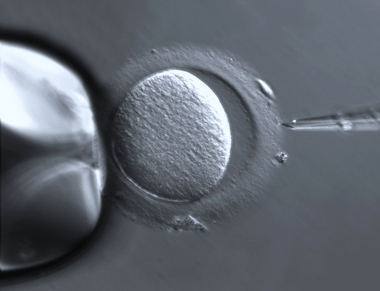UAlbany Study Examines Connections between Persistent Organic Pollutants and Infertility
 |
|
School of Public Health researcher Michael S. Bloom and his team found a significant negative association between higher levels of pollutants and response to IVF treatments. (Photo Courtesy Zeiss Microscopy)
|
ALBANY, N.Y. (July 6, 2017) -- Each year, millions of women face difficulties in getting pregnant. In the U.S., nearly four million women desired but were unable to conceive children in 2002, according to data from the National Survey of Family Growth.
The trend has been sharply rising in the last 35 years, and clinicians and investigators have expressed a growing concern that environmental pollutants are a substantial factor.
University at Albany researcher Michael S. Bloom and a team of scientists have taken a closer look at this dynamic in a new study for Reproductive Toxicology, and the findings suggest the cause for concern is deserved.
Bloom and his colleagues from the University of California, San Francisco and the New York State Department of Health’s Wadsworth Center determined the levels of persistent organic pollutants (POPs) found in 32 women undergoing in vitro fertilization (IVF). They found a significant negative association between higher levels of pollutants and response to treatments.
“Higher levels of POPs were associated with a lower probability for a live birth or pregnancy after IVF, as well as poorer embryo quality, response to administered fertility drugs and ovarian reserve,” said Bloom, an associate professor of Environmental Health Sciences at UAlbany’s School of Public Health. “Our results suggest that ongoing exposure to POPs impacts IVF and merit confirmation in a larger and more definitive study.”
For the pilot program, Bloom and his colleagues measured 43 polychlorinated biphenyl (PCB) congeners. These related chemical substances were once extensively deployed in manufacturing, and due to their longevity are still widely found in the environment. The researchers measured the levels found in 32 women undergoing fertility treatment, and after adjusting for body mass index, cigarette smoking, age and other factors, their results pointed to a significant harmful impact on IVF outcomes.
Considering the growing number of women who have reported difficulty conceiving and staying pregnant, the findings are alarming. Research suggests as many as 60 percent more women reported difficulty getting pregnant in 2002 as compared with 1982. For women under the age of 25, the number reporting problems rose 200 percent.
While the U.S. banned PCB manufacturing in 1979, their longevity in nature means humans are still exposed to the chemicals through ongoing contamination of food supplies.
But for Bloom and his colleagues, these low-level, ‘background’ exposures to PCBs may still be interfering with pregnancy, despite declining levels in the surrounding environment.
“In spite of decreases in environmental POPs and the increasing effectiveness of IVF, these preliminary results suggest that ongoing exposures still happen and are very much a problem requiring further study,” concluded Bloom.
![]() For more news, subscribe to UAlbany's RSS headline feeds
For more news, subscribe to UAlbany's RSS headline feeds
A comprehensive public research university, the University at Albany-SUNY offers more than 120 undergraduate majors and minors and 125 master's, doctoral and graduate certificate programs. UAlbany is a leader among all New York State colleges and universities in such diverse fields as atmospheric and environmental sciences, business, education, public health,health sciences, criminal justice, emergency preparedness, engineering and applied sciences, informatics, public administration, social welfare and sociology, taught by an extensive roster of faculty experts. It also offers expanded academic and research opportunities for students through an affiliation with Albany Law School. With a curriculum enhanced by 600 study-abroad opportunities, UAlbany launches great careers.


